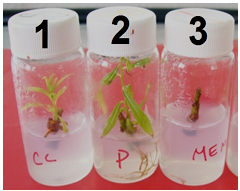In vitro propagation of Salix babylonica L. from nodal segments
Main Article Content
Abstract
Downloads
Article Details
References
BALL, J., CARLE, J. y LUNGO, A. del, 2005. Contribución de álamos y sauces a la silvicultura sostenible y al desarrollo rura Unasylva [en línea], vol 56. [Consulta: 9 junio 2020]. Disponible en: http://www.fao.org/3/a0026s/a0026s02.htm.
BONNART, R., WADDELL, J., HAIBY, K., WIDRLECHNER, M. P. & VOLK, G. M. 2014. Cryopreservation of Populus Trichocarpa and Salix Dormant Buds with Recovery by Grafting or Direct Rooting. Cryoletters, Volume 35, Number 6, November, pp. 507-515(9). Disponible: https://core.ac.uk/download/pdf/38935709.pdf
CASTILLO DUVERGEL, Y. y MIRANDA, I., 2014. COMPAPROP: Sistema para comparación de proporciones múltiples. Revista Protección Vegetal [en línea], vol 29, no. 3, pp. 231-234. [Consulta: 9 junio 2020]. ISSN 1010-2752. Disponible en: http://scielo.sld.cu/scielo.php?script=sci_arttext&pid=S1010-27522014000300013.
CHORNOBROV, O.Yu., 2015. Biotechnological aspects of Salix matsudana Koidz. «Tortuosa» rehd. plants micropropagation. Ukranian Journal of Forest and Wood Sciences [en línea], vol 219. [Consulta: 9 junio 2020]. Disponible en: http://webcache.googleusercontent.com/search?q=cache:gn9ZSTy5SOEJ:journals.nubip.edu.ua/index.php/Lisivnytstvo/article/view /10382+&cd=2&hl=es&ct=clnk&gl=cu.
CHORNOBROV, O.Y., BILOUS, S., CHORNOBROV, O. & MANKO, M. 2019. Peculiarities of morphogenesis of the endangered species of wilow (Salix spp.) in vitro. Biologija Vol 65 No 1. P. 4855. Disponible en: https://www.semanticscholar.org/paper/Peculiarities-of-morphogenesis-of-the-endangered-of-Chornobrov-Bilous/6d548a55153f37fb2acf588af70b54e27b126319
CHUNG, P. y CARRASCO, B., 1998. Micropropagación de Salix spp. a través de meristemos foliares. Ciencia e Investigación Forestal [en línea], vol 12, no. 1, pp. 63-77. Disponible en: https://bibliotecadigita infor.cl/bitstream/handle/20.500.12220/10921/18619.pdf?sequence=1&isAllowed=y.
DI RIENZO, J.A., 2005. Estadisticas para las ciencias agropecuarias [en línea]. S.: Editorial Brujas. [Consulta: 23 marzo 2020]. ISBN 978-987-1142-68-2. Disponible en: http://dspace.utalca.cl/handle/1950/3425.
DOFFO, G.N., ACHINELLI, F.G., RODRÍGUEZ, M.E. y LUQUEZ, V.M., 2017. Rendimiento de un sistema de rotación corta de alta densidad con Salix spp. en Buenos Aires, Argentina. Bosque (Valdivia) [en línea], vol 38, no. 3, pp. 587-592. [Consulta: 9 junio 2020]. ISSN 0717-9200. DOI 10.4067/S0717-92002017000300016. Disponible en: https://scielo.conicyt.cl/scielo.php?script=sci_abstract&pid=S0717-92002017000300016&lng=es&nrm=iso&tlng=es.
GHASEMI, R. y MOKHTARI, R., 2019. Cyanide acclimation in willow (Salix babylonica), a prospect for the phytoremediation of cyanide. Journal of Plant Process and Function [en línea], vol 7, no. 28, pp. 61-69. [Consulta: 9 junio 2020]. Disponible en: http://jispp.iut.ac.ir/article-1-641-en.htm
GÓMEZ, A., PINTOS, B., GRAU, J. y BUENO, M., 2014. Micropropagación de Populus tremula Reduca [en línea], vol 7, pp. 1-11. Disponible en: https://www.researchgate.net/publication/264228990_Micropropagacion_de_Populus_tremula_
GONZÁLEZ ALAMILLA, E., GONZÁLEZ CORTÁZAR, M., CARRANZA, B., RIVAS JACOBO, M., HERRERA CORREDOR, C., OJEDA RAMÍREZ, D., ZARAGOZA, A. y RIVERO, N., 2019. Chemical Constituents of Salix babylonica and Their Antibacterial Activity Against Gram-Positive and Gram-Negative Animal Bacteria. Molecules [en línea], vol 24. DOI 10.3390/molecules24162992. Disponible en: https://www.researchgate.net/publication/335241099_Chemical_Constituents_of_ Salix_babylonica_L_and_Their_Antibacterial_Activity_Against_Gram -Positive_and_Gram-Negative_Animal_Bacteria.
GRENDYSZ, J., JACEK, W. y DANUTA, K., 2017. Influence of micropropagation with addition of kinetin on development of a willow (Salix viminalis). World Scientific News [en línea], vol 70, pp. 201-215. Disponible en: https://www.researchgate.net/publication/322931611_Influence_of_micropropagation_with_addition_of_kinetin_on_development_of_a_willow_ Salix_viminalis_
IMRAN, K., AHMAD, N., ANIS, M., ALATAR, A.A. & FAISAL, M. 2018. In vitro conservation strategies for the Indian willow (Salix tetrasperma Roxb.), a vulnerable tree species via propagation through synthetic seeds. Biocatalysis and Agricultural Biotechnology. Vol 16, October, Pages 17-21. Disponible en: https://www.sciencedirect.com/science/article/abs/pii/S1878818118300045
LÓPEZ, M., SOLÓRZANO, F., POMAGUALLI, D., LÓPEZ, T. y VERGARA, G., 2016. Propagación in vitro del sauce llorón (Salix Babilonica Lin.) a partir de segmentos nodales. Revista de Investigación Talentos [en línea], vol 3, no. 2, pp. 22-29. [Consulta: 9 junio 2020]. ISSN 2631-2476. Disponible en: http://190.15.128.230/index.php/talentos/article/view/59.
MURASHIGE, T. y SKOOG, F., 2006. A Revised Medium for Rapid Growth and Bio Assays with Tobacco Tissue Cultures. Physiologia Plantarum [en línea], vol 15, pp. 473-497. DOI 10.1111/j.1399-3054.1962.tb08052.x. Disponible en: https://www.researchgate.net/publication/227590930_A_Revised_Medium_for_Rapid_Growth_and_Bio_Assays_with_Tobacco_Tissue_Cultures
NAUJOKS, G. 2007. Micropropagation of Salix caprea En: Protocols for Micropropagation of Woody Trees and Fruits, S.M. Jain and H. Häggman (eds.), 213220. Springer. Disponible en: https://www.springer.com/gp/book/9781402063510
PALOMO RIOS, E., MACALPINE, W., SHIELD, I., AMEY, J., KARAOÐLU, C., WEST, J., HANLEY, S., KRYGIER, R., KARP, A. y JONES, H., 2015. Efficient method for rapid multiplication of clean and healthy willow clones via in vitro propagation with broad genotype applicability. Canadian Journal of Forest Research [en línea], vol 45, pp. 1-6. DOI 10.1139/cjfr-2015-0055. Disponible en: https://www.researchgate.net/publication/282160376_Efficient_method_for_rapid_multiplication_of_clean_and_healthy_willow_clones_via_in_vitro_propagation_with_broad_genotype_applicability.
REGUEIRA, M., RIAL, E., BLANCO, B., BOGO, B., ALDREY, A., CORREA, B., VARAS, E., SÁNCHEZ, C. y VIDAL, N., 2018. Micropropagation of axillary shoots of Salix viminalis using a temporary immersion system. Trees [en línea], vol 32, no. 1, pp. 61-71. [Consulta: 9 junio 2020]. ISSN 1432-2285. DOI 10.1007/s00468-017-1611-x. Disponible en: https://link.springer.com/article/10.1007/s00468-017-1611-x.
RIVERO, N., HERNÁNDEZ ALVARADO, J., CARRANZA, B., DELGADILLO, , OJEDA RAMÍREZ, D., SOSA GUTIÉRREZ, C., UBALDO, , VEGA SÁNCHEZ, V. y ZARAGOZA, A., 2019. Salix babylonica as a Natural Anticoccidial Alternative in Growing Rabbits. Evidence-Based Complementary and Alternative Medicine [en línea], vol 2019, pp. 1-8. DOI 10.1155/2019/2107231. Disponible en: https://www.researchgate.net/publication/335480904_ Salix_babylonica_L_as_a_Natural_Anticoccidial_Alternative_in_Growing_Rabbits.
SANTOS, B.R., PAIVA, R., MARTINOTTO, C.. NOGUEIRA, R.C., DUARTE, P. 2005. Indução de calos friáveis em explantes foliares de Salix (Salyx humboldtiana Willd). Cienc. Rural vol 35 no.3 Santa Maria May/June. Disponible en: https://www.scielo.br/scielo.php?script=sci_arttext&pid=S0103-84782005000300004&lang=pt
SKÁLOVÁ, D., NAVRÁTILOVÁ, B., RICHTEROVÁ, , KNIT. M., SOCHOR, M., & RADIM VAŠUT, R. 2012. Biotechnological methods of in vitro propagation in willows (Salix spp.). Central European Journal of Biology. Vol 7. No.5. 931-940. Disponible en: https://www.researchgate.net/publication/240919703_Biotechnological_methods_of_in_vitro_propagation_in_willows_Salix_spp
WAHAB, G., SALLAM, A., ELGAML, A., LAHLOUB, M.F. y AFIF, M., 2018. Antioxidant and antimicrobial activities of Salix babylonica extracts. World Journal of Pharmaceutical Sciences [en línea], vo 6, pp. 1-6. Disponible en: https://www.researchgate.net/publication/325229842_Antioxidant_and_antimicrobial_activities_of_ Salix_babylonica_extracts.


